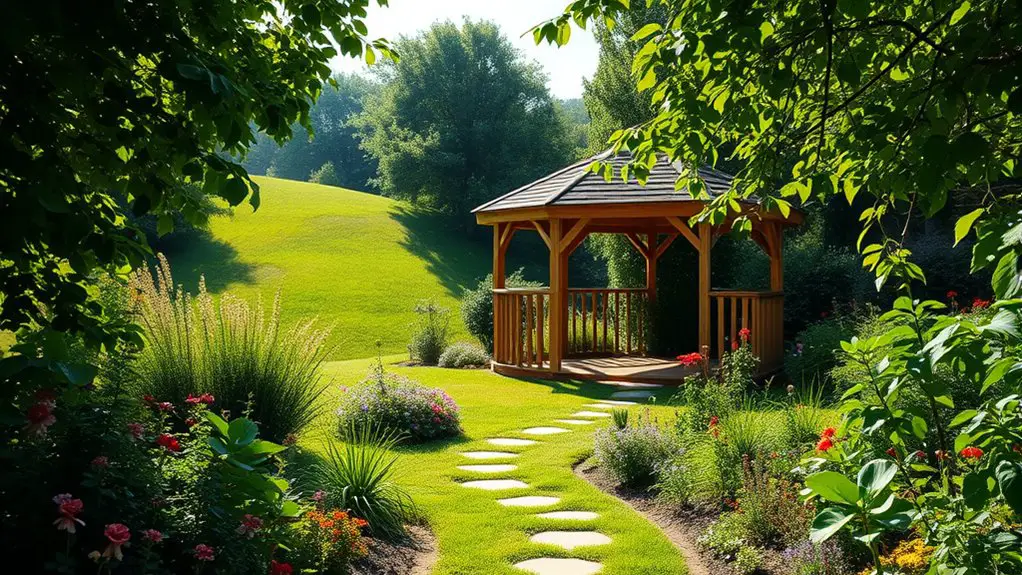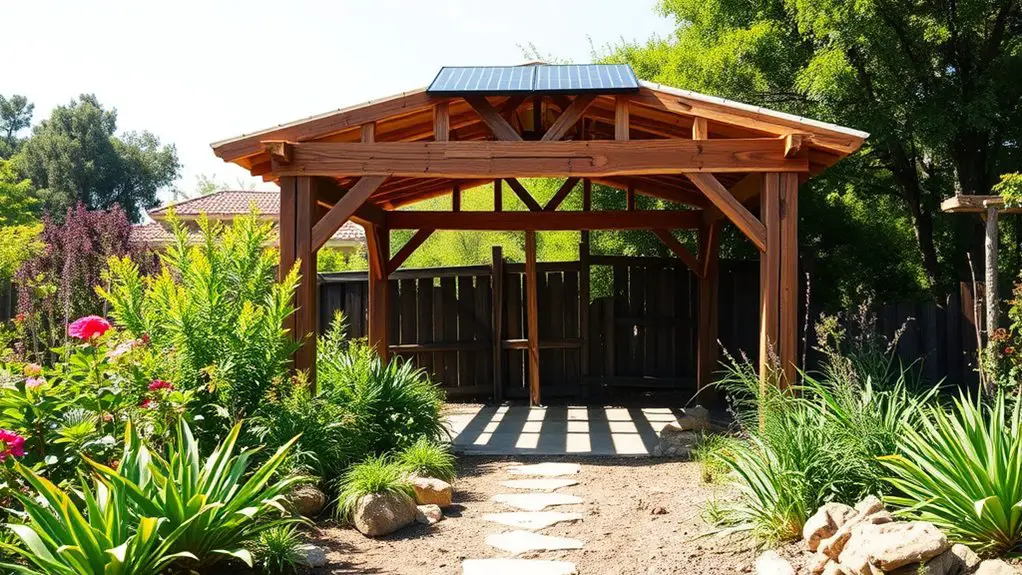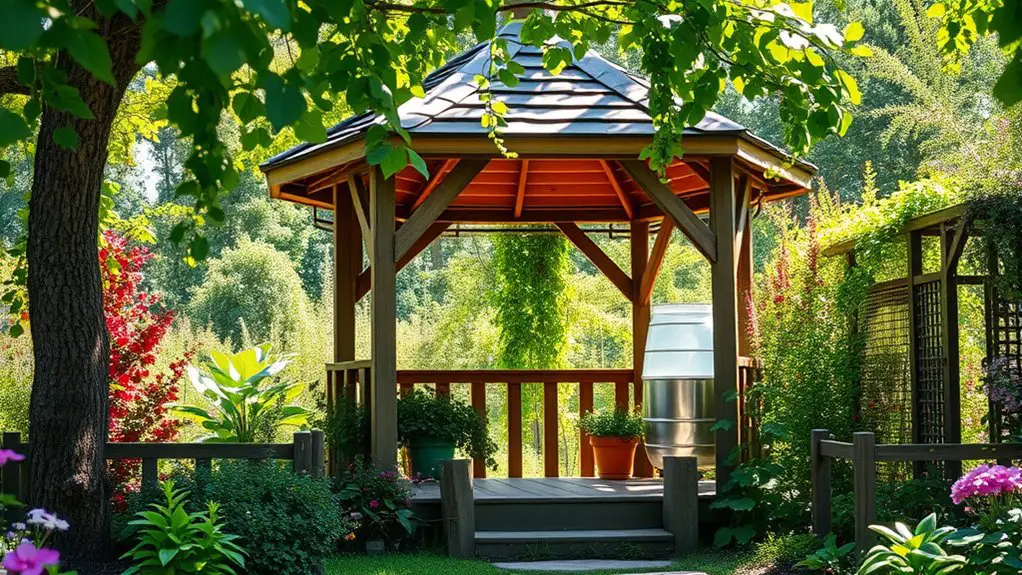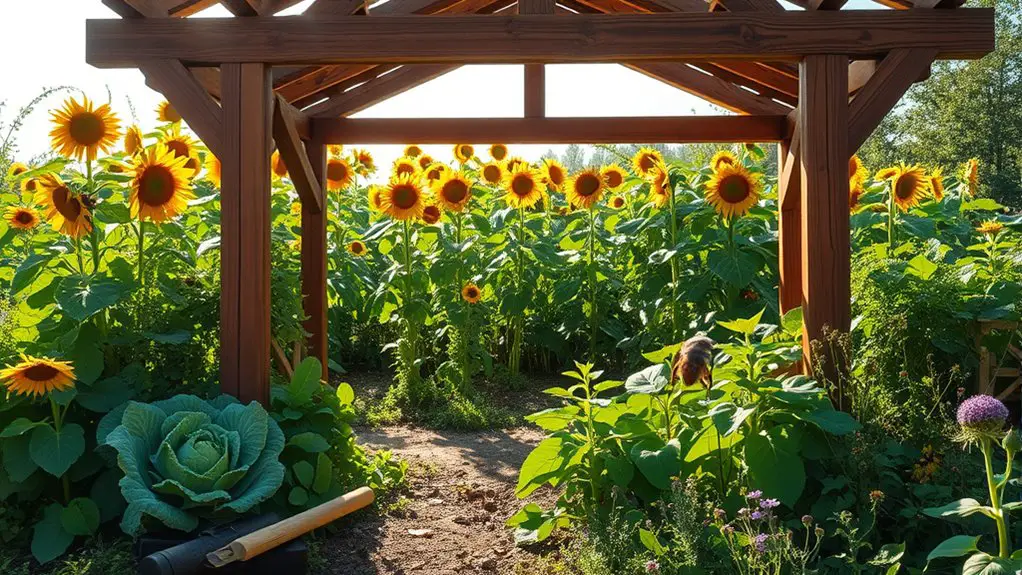To build a gazebo in your permaculture garden, start by choosing a harmonious location that offers shade and wind protection. Use sustainable materials like recycled wood or natural stone to enhance ecological balance. Design your gazebo with features like rainwater catchment and climbing plants to support local biodiversity. Construct it with a solid foundation and eco-friendly drainage. By implementing these practices, you’ll create a relaxing space that complements your garden beautifully. There’s so much more to explore!
Choosing the Right Location for Your Gazebo

When you’re choosing the right location for your gazebo, it’s essential to contemplate the harmony of your permaculture garden. The spot you select should embrace the natural elements, allowing you to enjoy the beauty of your surroundings. Consider the sunlight exposure; a well-positioned gazebo can provide just the right amount of shade during those hot summer days, enhancing your garden’s microclimate.
Additionally, think about wind protection. Placing your gazebo near existing trees or shrubs can create a cozy refuge from the elements, giving you a peaceful space to relax and connect with nature. This strategic placement not only supports your comfort but also harmonizes with the ecological balance of your garden. Furthermore, consider the importance of sun and wind exposure in determining the optimal placement for your gazebo to maximize its functionality and aesthetic appeal.
Ultimately, your gazebo should blend seamlessly into the landscape, inviting you to unwind and revel in the freedom that your sustainable sanctuary offers. Choose wisely, and your gazebo will become a cherished haven.
Designing Your Gazebo With Permaculture Principles
While designing your gazebo, incorporating permaculture principles can enhance both its functionality and its integration into your garden ecosystem. Think about how your gazebo can support the overall health of your garden while embodying permaculture aesthetics. Consider these elements:
- Natural shading: Position your gazebo near tall plants or trees to create a comfortable, cool space, reducing the need for artificial cooling.
- Water catchment: Design a roof that collects rainwater, directing it to nearby plants, enriching the soil naturally.
- Biodiversity-friendly features: Incorporate climbing plants and native flowers to attract pollinators, fostering a vibrant ecological design. Additionally, consider how your gazebo can serve as a focal point in garden design, enhancing the visual appeal of your permaculture garden.
Selecting Sustainable Materials

Choosing sustainable materials for your gazebo not only supports environmental health but also enhances the aesthetic appeal of your permaculture garden. Start with recycled wood, which not only helps reduce waste but also adds character and warmth to your structure. Look for local sources to minimize transportation emissions and keep your community thriving.
Incorporate natural stone for a strong, durable foundation and a beautiful, organic look. Stones blend seamlessly with the landscape, offering stability while encouraging biodiversity. Selecting materials that are both eco-friendly and locally sourced allows you to create a space that resonates with the freedom of nature. Consider using naturally resistant wood types like cedar and redwood to further enhance the longevity and sustainability of your structure.
Consider finishing touches that align with your values, using non-toxic, biodegradable treatments to protect your materials. By prioritizing sustainable choices, you’re crafting a gazebo that harmonizes with the environment and reflects your commitment to a holistic lifestyle. Enjoy the freedom that comes with building consciously!
Constructing Your Gazebo
Begin by laying a solid foundation for your gazebo, as this will guarantee its longevity and stability in your permaculture garden. Choose from various foundation types that suit your landscape:
- Concrete footings – Perfect for a sturdy base, ensuring your structure withstands the elements.
- Gravel pads – Eco-friendly and simple, these allow for drainage while providing support.
- Wooden posts – A natural choice that blends seamlessly with your garden, promoting sustainability.
Next, select roofing options that enhance your gazebo’s aesthetic while being functional. Consider using reclaimed wood or metal for a rustic charm, or opt for living roofs adorned with plants, creating a mini-ecosystem overhead. Additionally, incorporating proper drainage is essential to prevent water damage and enhance the durability of your gazebo.
As you construct your gazebo, remember to embrace the holistic principles of permaculture. This isn’t just a structure; it’s a sanctuary, a space for freedom, relaxation, and connection with nature. Your gazebo will be a beautiful addition to your garden.
Enhancing Your Gazebo With Permaculture Features

A gazebo can become a vibrant hub of biodiversity when you incorporate permaculture features into its design. Start by integrating water collection systems like rain barrels beneath the gazebo’s eaves. This not only supports your garden’s hydration needs but also creates a functional beauty. Consider adding native plants around your gazebo, as they attract pollinators and enhance the local ecosystem. Climbing plants, such as beans or vines, can be encouraged to grow along the structure, providing shade while contributing to plant integration and food production.
Use natural materials and composting features nearby to enrich the soil, promoting a closed-loop system. Embrace the freedom of creating a space that connects you to nature, where you can relax and observe the flourishing life around you. By enhancing your gazebo with these permaculture principles, you’re not just building a shelter; you’re crafting a sanctuary for both you and the ecosystem. Additionally, using durable materials for your gazebo will ensure its weather resistance, allowing it to withstand various environmental conditions while serving as a reliable gathering spot.
Frequently Asked Questions
How Much Does It Typically Cost to Build a Gazebo?
Building a gazebo? It’s just a small fortune! Depending on your chosen gazebo materials and designs, you might find costs ranging from a few hundred to several thousand dollars. Freedom isn’t cheap, huh?
What Tools Do I Need for Gazebo Construction?
For your gazebo, you’ll need essential tools like a saw, hammer, and level. When considering tool selection, prioritize sustainable materials, ensuring your construction aligns with ecological principles, promoting freedom in your creative expression and connection to nature.
Can I Hire Someone to Build My Gazebo?
Sure, you can hire professionals for your gazebo. They can bring unique gazebo designs to life, ensuring it’s eco-friendly and blends into your space beautifully. It’s a great way to embrace freedom in your garden!
How Long Does It Take to Build a Gazebo?
Building a gazebo can feel like nurturing a seed into a tree. Depending on design considerations and gazebo materials, it typically takes a few days to a couple of weeks, ensuring every detail aligns with nature’s rhythm.
Are There Permits Required for Building a Gazebo?
You’ll likely need permits for building a gazebo, depending on your location. Check local zoning regulations for permit types, ensuring your project aligns with sustainable practices while embracing freedom in your personal space.

